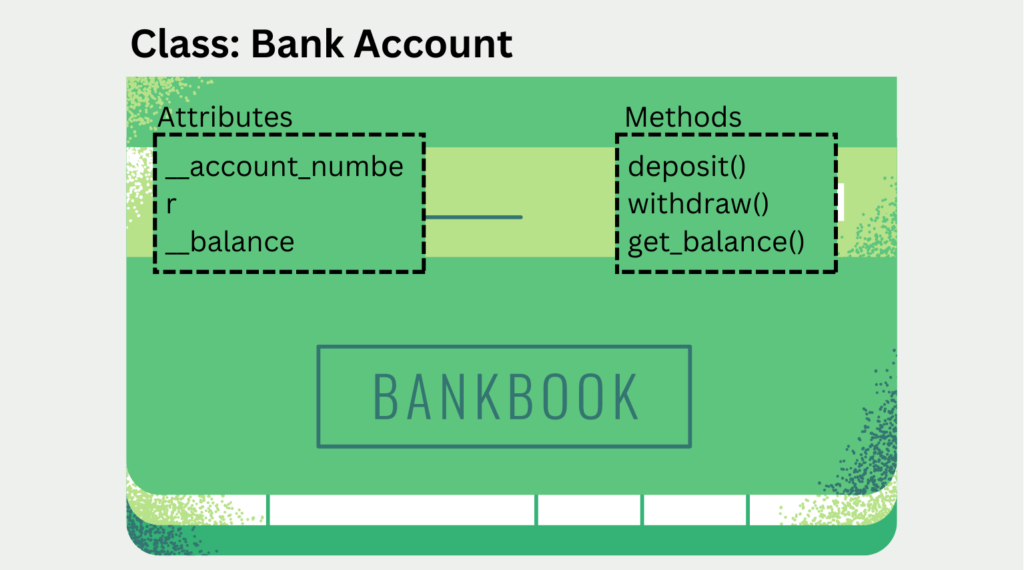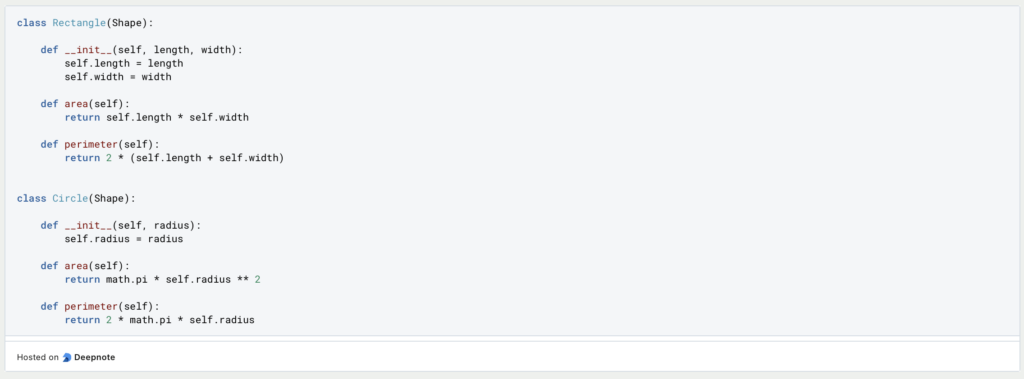Object-oriented programming (OOP) is a programming paradigm that is based on the concept of “objects”, which can contain data and code to manipulate that data. OOP is a popular programming paradigm, used in many different programming languages, including Python, Java, and C++. In this article, we will focus on OOP in Python.
What are the Basics of Object-Oriented Programming?
Object-oriented programming is a programming paradigm that is based on the concept of objects, which can contain data and code that acts on that data. The basic idea is to create a blueprint for an object, which is called a class. Objects are instances of classes, and they have their own unique data and behavior.
There are four basic concepts in object-oriented programming:
- Encapsulation: This is the practice of keeping data and code that operates on that data in a single unit, called a class. Encapsulation allows for better control of access to the data and ensures that the data is kept safe from external manipulation.
- Inheritance: This allows one class to inherit properties and methods from another class. This is useful for creating specialized classes that are similar to a base class but with additional functionality.
- Polymorphism: This is the ability to use a single method name to perform different actions based on the object that is calling the method. This is achieved through the use of interfaces or abstract classes.
- Abstraction: This is the practice of hiding the implementation details of a class and exposing only the necessary methods and properties. This allows for simpler and more flexible code that can be easily modified.
In object-oriented programming, the emphasis is on creating reusable code and creating objects that can be used in a variety of contexts. This makes programming more efficient, as code can be written once and reused multiple times.

Python is an object-oriented programming language that supports these concepts, making it a powerful tool for creating complex programs. Python also has a number of built-in functions and modules that make it easy to work with objects and classes.
How is it implemented in Python?
In Python, everything is an object, and we can create our own objects by defining classes. A class is a blueprint or a template for creating objects that have similar characteristics. It defines the properties and behaviors of an object. Once a class is defined, we can create objects from it, which are instances of that class.
Here’s an example of a simple class in Python:

In this example, we have defined a class named Car, which has three attributes: brand, model, and year. The __init__() method is a special method that initializes the object’s attributes when it is created. The drive() method is a behavior of the Car class.
To create an object from this class, we can do the following:

In this example, we have created an object named my_car from the Car class. We have passed the make, model, and year attributes to the __init__() method.
Encapsulation
Encapsulation is a fundamental concept of object-oriented programming, which refers to the practice of hiding the internal details of an object and exposing only the necessary functionality to the outside world. In Python, we can achieve encapsulation by defining attributes and methods as either private or public.
Private attributes and methods are denoted by a double underscore (__) prefix, and they can only be accessed within the class. Public attributes and methods are accessible from outside the class.
Here’s an example:

In this example, we have defined a class named BankAccount, which has two private attributes: __account_number and __balance. These attributes can only be accessed within the class. We have also defined three public methods: deposit(), withdraw(), and get_balance(). These methods can be accessed from outside the class.

Inheritance
Inheritance is a fundamental concept in object-oriented programming, and Python supports inheritance in its class hierarchy. Inheritance allows a class to be based on another class, inheriting all the attributes and methods of the parent class. This allows for code reuse and promotes code modularity, making it easier to manage and update a large codebase.
In Python, inheritance is achieved by creating a new class that derives from an existing class. The new class is called the “child” or “subclass”, and the existing class is called the “parent” or “superclass”. The child class inherits all the attributes and methods of the parent class, and can also add its own attributes and methods or override those of the parent class.
To create a subclass in Python, you can define a new class and specify the parent class in parentheses after the class name. Here’s an example:

In this example, we have a parent class called Animal, which has an __init__ method that initializes the name attribute and a speak method that doesn’t do anything. We also have two child classes, Dog and Cat, which inherit from the Animal class and override the speak method to return the respective animal sound.
When we create an instance of Dog or Cat, it will inherit the name attribute from the Animal class and the speak method from the child class:

Inheritance also supports a concept called method resolution order (MRO), which determines the order in which methods are searched for in the class hierarchy. In Python, the MRO is determined using a depth-first search of the class hierarchy, following the order of inheritance specified in the class definition. The MRO can be accessed using the mro method on a class:

This shows that the MRO for the Dog class is [Dog, Animal, object], meaning that Python will first look for methods in the Dog class, then the Animal class, and finally the built-in object class.
Inheritance can also be used to create multiple levels of subclasses, with each child class inheriting from its parent class. This can be useful for organizing classes into a hierarchy and promoting code reuse.
In conclusion, inheritance is a powerful feature of object-oriented programming that allows for code reuse and promotes code modularity. Python supports inheritance in its class hierarchy, making it easy to create subclasses that inherit attributes and methods from a parent class.
Polymorphism
Polymorphism is a fundamental concept in object-oriented programming that allows objects to take on different forms or behaviors depending on their context. The term “polymorphism” comes from the Greek words “poly,” meaning many, and “morph,” meaning form or shape.
In Python, polymorphism is achieved through method overloading and method overriding.
Method overloading allows a class to have multiple methods with the same name but different parameters. When a method is called, Python will automatically determine which method to use based on the number and types of arguments passed.
For example, consider a class called Shape that has a method called area(). This method can be overloaded to take different parameters for different shapes. A Rectangle object could have an area() method that takes two parameters, length and width, while a Circle object could have an area() method that takes a single parameter, radius.
Method overriding, on the other hand, allows a subclass to provide its own implementation of a method that is already defined in its superclass. When a method is called on an object of the subclass, the subclass’s implementation of the method is used instead of the superclass’s.
For example, consider a class hierarchy consisting of a superclass called Animal and two subclasses called Cat and Dog. The Animal class has a method called speak() that returns a generic animal sound. The Cat and Dog classes can override the speak() method to return their own specific sounds.

Polymorphism is a powerful feature of object-oriented programming that allows for code reuse and flexibility. It enables objects to be treated in a generic way, without knowing their specific types, and allows for the creation of more modular and maintainable code.
Abstraction
Abstraction is an important concept in object-oriented programming that allows us to focus on the essential features of an object while hiding unnecessary details. In Python, we can use the concept of abstraction to create abstract classes and methods.
An abstract class is a class that cannot be instantiated and serves only as a blueprint for other classes to inherit from. It defines the basic structure and behavior that the derived classes must implement. To define an abstract class in Python, we use the abc module, which stands for abstract base classes.
For example, let’s say we want to create a Shape class that serves as a base class for other shapes like Rectangle and Circle. We can define the Shape class as an abstract class using the abc module:

In this example, we define the Shape class as an abstract class by using the abc.ABCMeta metaclass. We also define two abstract methods, area() and perimeter(), which do not have an implementation in the Shape class. These methods must be implemented in any derived classes that inherit from Shape.
We can now create derived classes like Rectangle and Circle that inherit from the Shape class and provide their own implementations for the area() and perimeter() methods:

In this example, we define the Rectangle and Circle classes as derived classes of Shape. We provide implementations for the area() and perimeter() methods in each of these classes.
By using abstraction in our code, we can create a clean and organized structure that separates the essential features of our objects from the unnecessary details. This makes our code more maintainable, reusable, and easier to understand.
This is what you should take with you
- Object-oriented programming is a powerful paradigm used to create modular and reusable code.
- Python is a popular language for object-oriented programming because of its simplicity and flexibility.
- Inheritance, a fundamental concept of object-oriented programming, allows a class to inherit attributes and methods from a parent class, enabling code reuse and reducing redundancy.
- Polymorphism allows different classes to be treated as if they were the same type, simplifying code and promoting flexibility.
- Abstraction allows developers to focus on the essential details of an object while hiding unnecessary complexity in object-oriented programming.
- When used effectively, object-oriented programming in Python can lead to more efficient, maintainable, and scalable code.
Thanks to Deepnote for sponsoring this article! Deepnote offers me the possibility to embed Python code easily and quickly on this website and also to host the related notebooks in the cloud.
What is Jenkins?
Mastering Jenkins: Streamline DevOps with Powerful Automation. Learn CI/CD Concepts & Boost Software Delivery.
What are Conditional Statements in Python?
Learn how to use conditional statements in Python. Understand if-else, nested if, and elif statements for efficient programming.
What is XOR?
Explore XOR: The Exclusive OR operator's role in logic, encryption, math, AI, and technology.
How can you do Python Exception Handling?
Unlocking the Art of Python Exception Handling: Best Practices, Tips, and Key Differences Between Python 2 and Python 3.
What are Python Modules?
Explore Python modules: understand their role, enhance functionality, and streamline coding in diverse applications.
What are Python Comparison Operators?
Master Python comparison operators for precise logic and decision-making in programming.
Other Articles on the Topic of Object-Oriented Programming
This link will get you to my Deepnote App where you can find all the code that I used in this article and can run it yourself.

Niklas Lang
I have been working as a machine learning engineer and software developer since 2020 and am passionate about the world of data, algorithms and software development. In addition to my work in the field, I teach at several German universities, including the IU International University of Applied Sciences and the Baden-Württemberg Cooperative State University, in the fields of data science, mathematics and business analytics.
My goal is to present complex topics such as statistics and machine learning in a way that makes them not only understandable, but also exciting and tangible. I combine practical experience from industry with sound theoretical foundations to prepare my students in the best possible way for the challenges of the data world.





